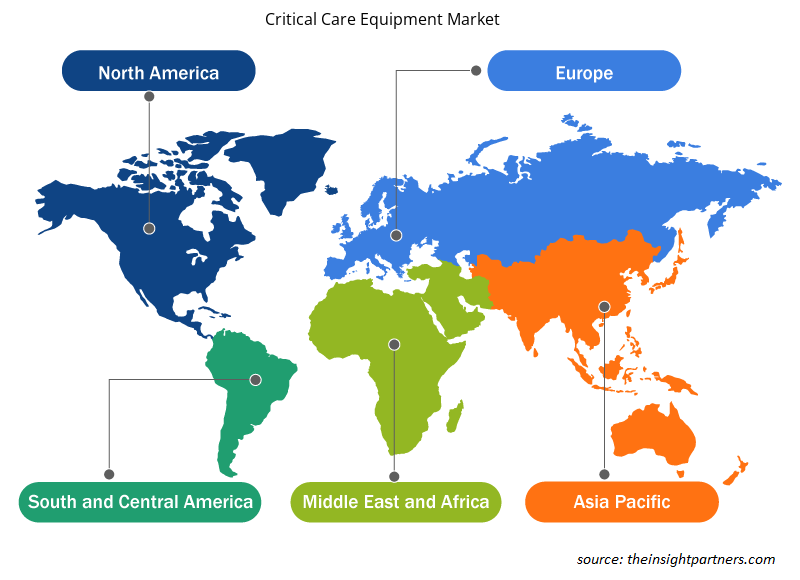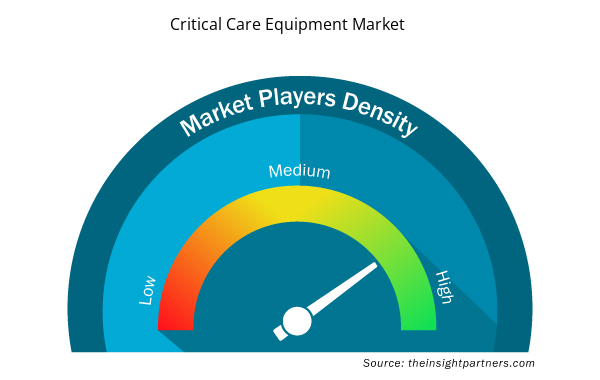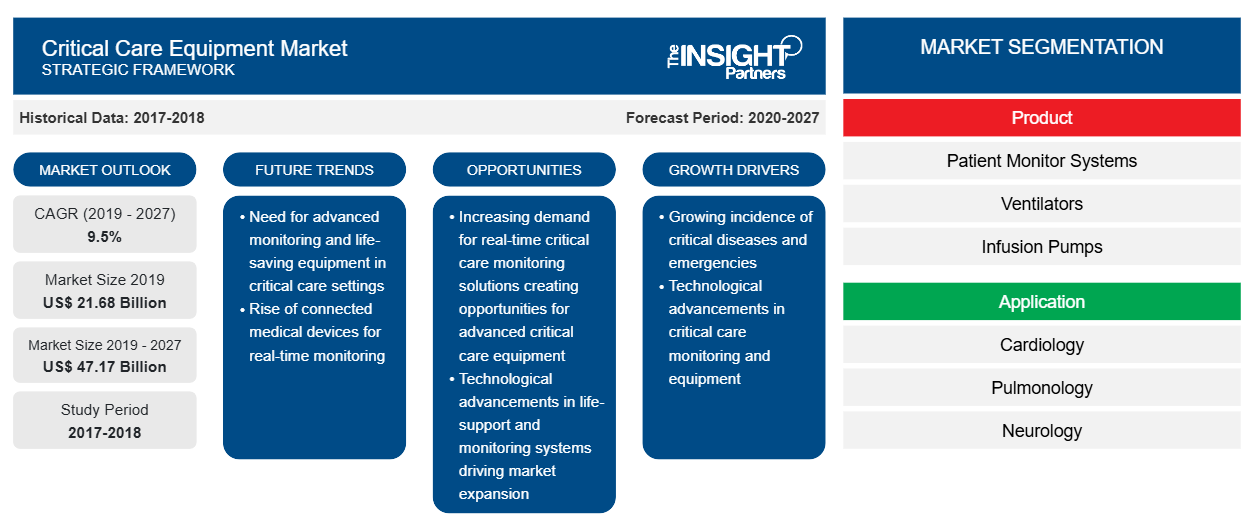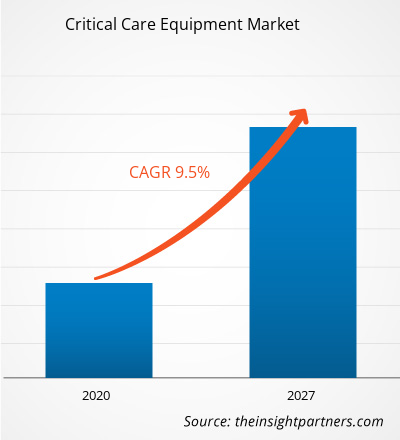Le marché des équipements de soins intensifs a été évalué à 21 682,65 millions USD en 2019 et devrait atteindre 47 171,42 millions USD d'ici 2027 ; il devrait croître à un TCAC de 9,5 % au cours de la période 2020-2027.
Les patients infectés passent en moyenne 15 jours en unité de soins intensifs. Selon la Société européenne d'anesthésiologie, le nombre de lits de soins intensifs en Italie continue d'augmenter. En Lombardie, avant la propagation du coronavirus, il y avait 140 lits de soins intensifs privés et 500 lits de soins intensifs publics, ce chiffre est passé à plus de 900 fin mars 2020.
Personnalisez ce rapport en fonction de vos besoins
Vous bénéficierez d'une personnalisation gratuite de n'importe quel rapport, y compris de certaines parties de ce rapport, d'une analyse au niveau des pays, d'un pack de données Excel, ainsi que d'offres et de remises exceptionnelles pour les start-ups et les universités.
- Obtenez les principales tendances clés du marché de ce rapport.Cet échantillon GRATUIT comprendra une analyse de données, allant des tendances du marché aux estimations et prévisions.
Informations sur le marché
Le nombre croissant de lits en unité de soins intensifs dans les pays à forte prévalence de COVID-19 devrait stimuler la croissance du marché
Le 11 mars 2020, l'Organisation mondiale de la santé a déclaré que la COVID-19 était une pandémie mondiale. Cette nouvelle maladie se caractérise par un nombre initial de cas plus faible, suivi d'une explosion des infections dans divers pays. Malgré la mise en œuvre de mesures de confinement pour réduire la propagation de la COVID-19, les systèmes de santé de divers pays ont été submergés par la demande d'équipements, tels que des lits de soins intensifs et du matériel de soutien pour traiter les cas graves de la maladie.
Aperçu des produits
En termes de produits, le segment des systèmes de surveillance des patients détenait la plus grande part du marché en 2019 et devrait continuer à être un actionnaire de premier plan au cours de la période de prévision. Cependant, le segment des ventilateurs devrait enregistrer un TCAC plus élevé sur le marché au cours de la période de prévision.
Informations sur les applications
Français En fonction des applications, le marché mondial des équipements de soins intensifs est segmenté en cardiologie, pneumologie, neurologie, orthopédie et autres. Le segment de la cardiologie détenait la plus grande part du marché en 2019, et le segment de la pneumologie devrait enregistrer le TCAC le plus élevé au cours de la période de prévision. Les soins intensifs cardiovasculaires sont la prise en charge systémique des patients atteints de maladies cardiovasculaires (MCV) graves, notamment de maladies vasculaires et de maladies cardiaques. Les MCV sont l'une des principales causes de décès dans le monde. Par exemple, selon l'Organisation mondiale de la santé, en 2016, environ 17,9 millions de personnes sont décédées de MCV, ce qui représente 31 % des décès dans le monde. De même, selon les Centers for Diseases Control and Prevention, environ 655 000 Américains meurent chaque année de maladies cardiaques. Pour prévenir les décès dus aux MCV, une unité de soins intensifs pour les patients atteints de MCV graves, à savoir l'unité de soins intensifs cardiovasculaires (CICU), est disponible dans les hôpitaux généraux. Les progrès technologiques de la cardiologie clinique, tels que les procédures et dispositifs interventionnels intracoronaires et la surveillance hémodynamique invasive, constituent les évolutions majeures des soins intensifs pour les maladies cardiovasculaires. Par conséquent, le nombre de patients atteints de maladies cardiovasculaires graves admis en USIC augmente chaque année. Les patients de l'USIC présentent de nombreuses complications telles qu'une insuffisance respiratoire et une insuffisance rénale. Par conséquent, un personnel médical formé est nécessaire pour pratiquer les soins intensifs systémiques.
Les collaborations et les partenariats technologiques des acteurs du marché des équipements de soins intensifs pour combler l’écart entre l’offre et la demande devraient jouer un rôle important dans la croissance du marché au cours de la période de prévision.
Aperçu régional du marché des équipements de soins intensifs
Les tendances et facteurs régionaux influençant le marché des équipements de soins intensifs tout au long de la période de prévision ont été expliqués en détail par les analystes d’Insight Partners. Cette section traite également des segments et de la géographie du marché des équipements de soins intensifs en Amérique du Nord, en Europe, en Asie-Pacifique, au Moyen-Orient et en Afrique, ainsi qu’en Amérique du Sud et en Amérique centrale.

- Obtenez les données régionales spécifiques au marché des équipements de soins intensifs
Portée du rapport sur le marché des équipements de soins intensifs
| Attribut de rapport | Détails |
|---|---|
| Taille du marché en 2019 | 21,68 milliards de dollars américains |
| Taille du marché d'ici 2027 | 47,17 milliards de dollars américains |
| Taux de croissance annuel composé mondial (2019-2027) | 9,5% |
| Données historiques | 2017-2018 |
| Période de prévision | 2020-2027 |
| Segments couverts | Par produit
|
| Régions et pays couverts | Amérique du Nord
|
| Leaders du marché et profils d'entreprises clés |
|
Densité des acteurs du marché des équipements de soins intensifs : comprendre son impact sur la dynamique commerciale
Le marché des équipements de soins intensifs connaît une croissance rapide, tirée par la demande croissante des utilisateurs finaux en raison de facteurs tels que l'évolution des préférences des consommateurs, les avancées technologiques et une plus grande sensibilisation aux avantages du produit. À mesure que la demande augmente, les entreprises élargissent leurs offres, innovent pour répondre aux besoins des consommateurs et capitalisent sur les tendances émergentes, ce qui alimente davantage la croissance du marché.
La densité des acteurs du marché fait référence à la répartition des entreprises ou des sociétés opérant sur un marché ou un secteur particulier. Elle indique le nombre de concurrents (acteurs du marché) présents sur un marché donné par rapport à sa taille ou à sa valeur marchande totale.
Les principales entreprises opérant sur le marché des équipements de soins intensifs sont :
- Compagnie Générale d'Électricité
- Medtronic
- B. Braun Melsungen AG
- Baxter International Inc.
- Royal Philips NV
Avis de non-responsabilité : les sociétés répertoriées ci-dessus ne sont pas classées dans un ordre particulier.

- Obtenez un aperçu des principaux acteurs du marché des équipements de soins intensifs
Par produit
- Systèmes de surveillance des patients
- Ventilateurs
- Ventilateurs invasifs
- Ventilateurs non invasifs
- Pompes à perfusion
- Autres
Par application
- Cardiologie
- Pneumologie
- Neurologie
- Orthopédique
- Autres
Par utilisateur final
- Hôpitaux
- Centres de soins ambulatoires
- Soins à domicile
- Autres
Par géographie
- Amérique du Nord
- NOUS
- Canada
- Mexique
- Europe
- France
- Allemagne
- Italie
- ROYAUME-UNI
- Russie
- Asie-Pacifique (APAC)
- Chine
- Inde
- Corée du Sud
- Japon
- Australie
- Moyen-Orient et Afrique (MEA)
- Afrique du Sud
- Arabie Saoudite
- Émirats arabes unis
- Amérique du Sud et Amérique centrale (SCAM)
- Brésil
- Argentine
Profils d'entreprise
- Compagnie Générale d'Électricité
- Medtronic
- B. Braun Melsungen AG
- Baxter International Inc.
- Royal Philips NV
- Getinge AB
- Hamilton Médical
- Löwenstein Medical UK Ltd.
- Dragerwerk AG & Co. KGaA
- Société Nihon Kohden
- Fisher & Paykel Soins de Santé Limitée.
- Shenzhen Mindray Biomedical Electronics Co., Ltd.
- BPL
- Trivitron Santé
- SKANRAY TECHNOLOGIES PVT LTD
- Société Asahi Kasei
- Analyse historique (2 ans), année de base, prévision (7 ans) avec TCAC
- Analyse PEST et SWO
- Taille du marché Valeur / Volume - Mondial, Régional, Pays
- Industrie et paysage concurrentiel
- Ensemble de données Excel



Report Coverage
Revenue forecast, Company Analysis, Industry landscape, Growth factors, and Trends

Segment Covered
This text is related
to segments covered.

Regional Scope
North America, Europe, Asia Pacific, Middle East & Africa, South & Central America

Country Scope
This text is related
to country scope.
Questions fréquemment posées
The disruption of supply chain and logistics due to the rapid spread of COVID-19 is the significant factor that will hinder the critical care equipment market growth.
The global critical care equipment market is being driven by factors such growing number of ICU beds in countries with a high prevalence of COVID-19 and increasing demand for ventilators for the effective management of critical COVID-19 patients. Furthermore, technological innovations in critical care equipment is likely to offer significant opportunities for the growth of the global critical care equipment market.
Critical care equipment includes cardiac support, patient monitoring, respiratory support, emergency resuscitation devices, pain management, and other life support equipment designed to care for critically ill patients or have undergone a major surgical procedure, thereby requiring 24-hour care monitoring.
Trends and growth analysis reports related to Life Sciences : READ MORE..
The List of Companies - Critical Care Equipment Market
- General Electric Company
- Medtronic
- B. Braun Melsungen AG
- Baxter International Inc.
- Koninklijke Philips N.V.
- Getinge AB
- Hamilton Medical
- Löwenstein Medical UK Ltd.
- Dragerwerk AG & Co. KGaA
- Nihon Kohden Corporation
- Fisher & Paykel Healthcare Limited.
- Shenzhen Mindray Biomedical Electronics Co., Ltd.
- BPL
- Trivitron Healthcare
- Skanray Technologies Pvt Ltd
- Asahi Kasei Corporation
The Insight Partners performs research in 4 major stages: Data Collection & Secondary Research, Primary Research, Data Analysis and Data Triangulation & Final Review.
- Data Collection and Secondary Research:
As a market research and consulting firm operating from a decade, we have published and advised several client across the globe. First step for any study will start with an assessment of currently available data and insights from existing reports. Further, historical and current market information is collected from Investor Presentations, Annual Reports, SEC Filings, etc., and other information related to company’s performance and market positioning are gathered from Paid Databases (Factiva, Hoovers, and Reuters) and various other publications available in public domain.
Several associations trade associates, technical forums, institutes, societies and organization are accessed to gain technical as well as market related insights through their publications such as research papers, blogs and press releases related to the studies are referred to get cues about the market. Further, white papers, journals, magazines, and other news articles published in last 3 years are scrutinized and analyzed to understand the current market trends.
- Primary Research:
The primarily interview analysis comprise of data obtained from industry participants interview and answers to survey questions gathered by in-house primary team.
For primary research, interviews are conducted with industry experts/CEOs/Marketing Managers/VPs/Subject Matter Experts from both demand and supply side to get a 360-degree view of the market. The primary team conducts several interviews based on the complexity of the markets to understand the various market trends and dynamics which makes research more credible and precise.
A typical research interview fulfils the following functions:
- Provides first-hand information on the market size, market trends, growth trends, competitive landscape, and outlook
- Validates and strengthens in-house secondary research findings
- Develops the analysis team’s expertise and market understanding
Primary research involves email interactions and telephone interviews for each market, category, segment, and sub-segment across geographies. The participants who typically take part in such a process include, but are not limited to:
- Industry participants: VPs, business development managers, market intelligence managers and national sales managers
- Outside experts: Valuation experts, research analysts and key opinion leaders specializing in the electronics and semiconductor industry.
Below is the breakup of our primary respondents by company, designation, and region:

Once we receive the confirmation from primary research sources or primary respondents, we finalize the base year market estimation and forecast the data as per the macroeconomic and microeconomic factors assessed during data collection.
- Data Analysis:
Once data is validated through both secondary as well as primary respondents, we finalize the market estimations by hypothesis formulation and factor analysis at regional and country level.
- Macro-Economic Factor Analysis:
We analyse macroeconomic indicators such the gross domestic product (GDP), increase in the demand for goods and services across industries, technological advancement, regional economic growth, governmental policies, the influence of COVID-19, PEST analysis, and other aspects. This analysis aids in setting benchmarks for various nations/regions and approximating market splits. Additionally, the general trend of the aforementioned components aid in determining the market's development possibilities.
- Country Level Data:
Various factors that are especially aligned to the country are taken into account to determine the market size for a certain area and country, including the presence of vendors, such as headquarters and offices, the country's GDP, demand patterns, and industry growth. To comprehend the market dynamics for the nation, a number of growth variables, inhibitors, application areas, and current market trends are researched. The aforementioned elements aid in determining the country's overall market's growth potential.
- Company Profile:
The “Table of Contents” is formulated by listing and analyzing more than 25 - 30 companies operating in the market ecosystem across geographies. However, we profile only 10 companies as a standard practice in our syndicate reports. These 10 companies comprise leading, emerging, and regional players. Nonetheless, our analysis is not restricted to the 10 listed companies, we also analyze other companies present in the market to develop a holistic view and understand the prevailing trends. The “Company Profiles” section in the report covers key facts, business description, products & services, financial information, SWOT analysis, and key developments. The financial information presented is extracted from the annual reports and official documents of the publicly listed companies. Upon collecting the information for the sections of respective companies, we verify them via various primary sources and then compile the data in respective company profiles. The company level information helps us in deriving the base number as well as in forecasting the market size.
- Developing Base Number:
Aggregation of sales statistics (2020-2022) and macro-economic factor, and other secondary and primary research insights are utilized to arrive at base number and related market shares for 2022. The data gaps are identified in this step and relevant market data is analyzed, collected from paid primary interviews or databases. On finalizing the base year market size, forecasts are developed on the basis of macro-economic, industry and market growth factors and company level analysis.
- Data Triangulation and Final Review:
The market findings and base year market size calculations are validated from supply as well as demand side. Demand side validations are based on macro-economic factor analysis and benchmarks for respective regions and countries. In case of supply side validations, revenues of major companies are estimated (in case not available) based on industry benchmark, approximate number of employees, product portfolio, and primary interviews revenues are gathered. Further revenue from target product/service segment is assessed to avoid overshooting of market statistics. In case of heavy deviations between supply and demand side values, all thes steps are repeated to achieve synchronization.
We follow an iterative model, wherein we share our research findings with Subject Matter Experts (SME’s) and Key Opinion Leaders (KOLs) until consensus view of the market is not formulated – this model negates any drastic deviation in the opinions of experts. Only validated and universally acceptable research findings are quoted in our reports.
We have important check points that we use to validate our research findings – which we call – data triangulation, where we validate the information, we generate from secondary sources with primary interviews and then we re-validate with our internal data bases and Subject matter experts. This comprehensive model enables us to deliver high quality, reliable data in shortest possible time.


 Obtenez un échantillon gratuit pour ce rapport
Obtenez un échantillon gratuit pour ce rapport